Before talking about the oven and the fryer, let's first understand the principles of heating, otherwise, the basic concepts may not be clear. Common cooking heating modes can be roughly divided into the following four types: heat radiation, heat convection, heat conduction, and phase change heat transfer. 1. Thermal radiation When it comes to thermal radiation, you may be very unfamiliar. In fact, it is very common in daily life. Cooking methods like grilling, the food is heated close to the reddish charcoal fire and the iron plate, which mainly uses the heat radiation from the heat source to transfer heat.
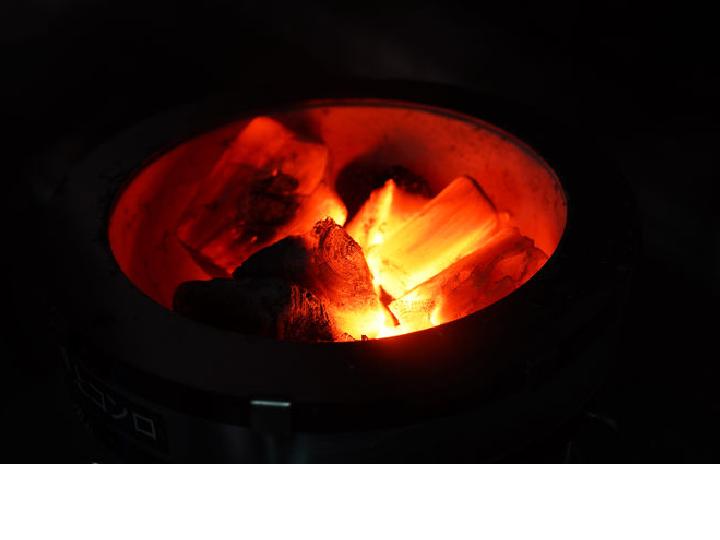
Generally, thermal radiation mainly relies on visible light and infrared rays with longer wavelengths. When the temperature is lower (about 500°C), the heat radiation is mainly infrared, and when the temperature is higher, both visible and infrared rays are both exist.It is worth noting that infrared is an invisible light, which is not in the visible spectrum for human beings. Therefore, it is not only a heat source that burns in the traditional sense, the oven has it, and some air fryer also has it.
Where does the heat radiation from the oven or fryer come from? The answer is the heating tube.
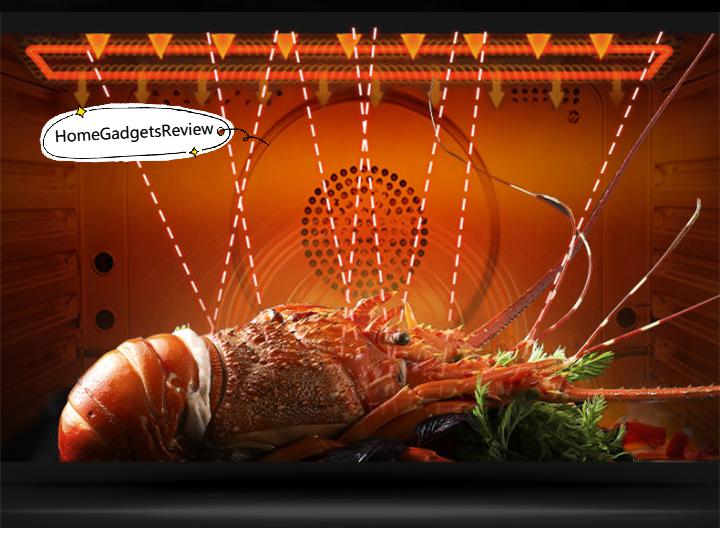
Since the nature of thermal radiation is light, the way of heat transfer will conform to the various characteristics of light. The more important characteristics are as follows:
The farther away from the heat source, the smaller the heating per unit area. As a kind of light, thermal radiation also conforms to the inverse square law of light, also known as the first law of illuminance. The expression formula is E=cL/r^2, where E is illuminance; L is luminous intensity; r is a light source to the distance from the surface of the illuminated object. This formula is more straightforward if it is understood in conjunction with the picture, that energy is emitted from a certain point, and it will eventually fall on a surface. If the distance is farther, the final surface will be larger, and the heating per unit area will be smaller. If the distance is doubled, the energy received by one unit is only 1/4 of the original. Therefore, the heating effect of the roast chicken is completely different when you put it on the top, close to the heating tube, and put it on the middle and lower layer.
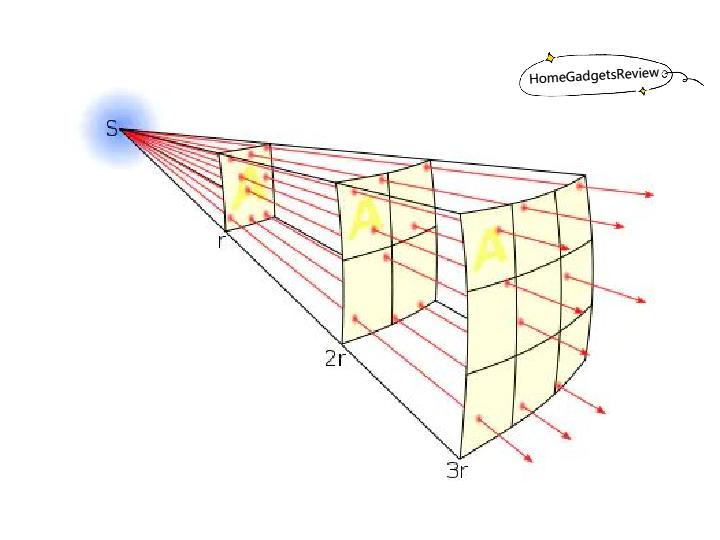
Reflective materials or shields can block the absorption of heat. This is easy to understand, because thermal radiation is a kind of light, so if the light is reflected or blocked, the thermal radiation cannot act on the ingredients directly. The tip of the chicken wings is wrapped with reflective tin foil to avoid burning and tin foil is used to conduct heat evenly. On the contrary, if the light acting on other positions is reflected to the ingredients, the heat absorption of the ingredients can also be increased. For example, some ovens will use light or even reflective oven walls.
2. Thermal convection
Yes, thermal convection is indeed the main heating form of ovens and fryers, but it is only one of them.
Thermal convection refers to the heat transfer process caused by the relative displacement of substances in the fluid, and it can only occur in the fluid. The simplest example is that after a cup of hot water is introduced into a cup of cold water, it will gradually become a cup of warm water due to the change in temperature and the flow of water. To the oven or the fryer, because their cavity is filled with air or water vapor, the air is also a fluid, so there will be thermal convection. The air temperature near the heating tube is high and the density is low. The air in other locations has low temperature but high density. This difference in density will cause the air in the oven to flow, so thermal convection is generated. This kind of convection without external force is called "natural convection heat transfer", and if you add a fan to forcefully agitate the air, the speed of this convection will increase. This kind of convection that exerts an external force is called "forced convection heat transfer."
Heat convection is very important for oven/air fryer cooking. We generally use the heat transfer coefficient (in W/(m^2*K)) to quantify the heat transfer capacity. When the air is naturally convective, the heat transfer coefficient is generally 5-25. If it is forced convection, the heat transfer coefficient can reach 20-300. Although it depends on various factors such as the ability of forced agitation (such as wind), on average, the heat transfer capacity of forced convection is 10 times of natural convection.

This is not difficult to understand that the heated air will become colder when it falls on the colder ingredients, if you rely on the natural flow when the cold air sinks and then replaced with hot air, the efficiency will be much lower and it will not be as good as forced convection. Therefore, an oven, with or without a fan, has a big impact on the final heating efficiency.
3. Thermal conduction
Heat conduction is the heat transfer phenomenon when there is no macroscopic movement in the medium. Although both solids and fluids produce heat conduction, pure heat conduction only occurs in solids. Because fluids flow freely, heat convection is much faster than heat conduction. Generally, when going to the inside of the food, it basically relies on heat conduction for heat transfer. But because the choice of ingredients may vary, thermal conduction is not a heat transfer method that really sets the difference between the oven and the air fryer.
4. Phase transition
Phase transition refers to the process by which a substance changes from one phase to another, such as liquid water becoming gaseous water vapor. From solid to liquid, from liquid to gas, matter absorbs heat and stores heat. On the contrary, it is a process of releasing heat.
For example, heating water to steam requires a lot of heat, how much is it? The heat required to heat boiling water into steam is 5 times as much as heating water of the same quality at 0°C into the boiling point! So, on the contrary, when water vapor encounters a lower temperature ingredient and condenses into water, it will release the absorbed heat again. This heat is also called latent heat of vaporization, and this method of transferring heat is called phase change heat transfer.
We mentioned earlier that the heat transfer coefficient (unit: W/(m^2*K)) is used to quantify the heat transfer capacity. The air is naturally convective, the heat transfer coefficient is generally about 5-25, and the forced convection heat transfer coefficient is 20-300. Then what is the heat transfer coefficient of water vapor condensation? 200-20000! It is 10-1000 times that of air!
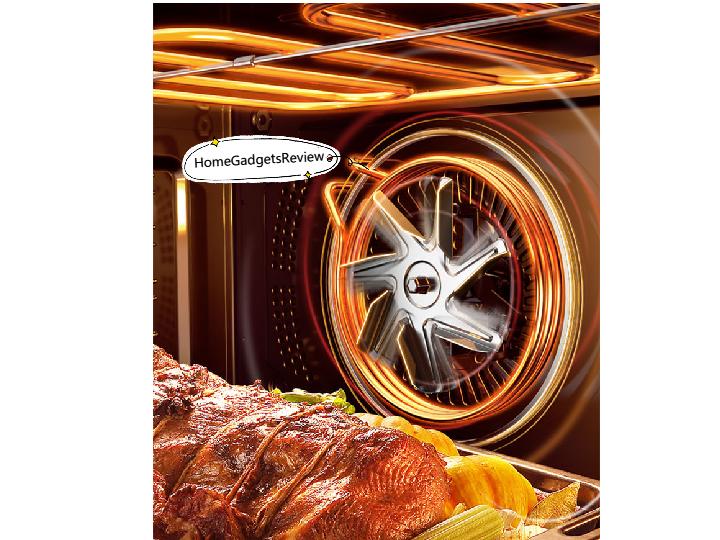
Therefore, the dry oven is preheated to 100°C, and you can put your hands in it and you won’t feel hot immediately, but if it’s a 100°C steaming box, you will get burned immediately by the steam when you put your hands in it, even worse than stretching your hands into the boiling water.
Where's the steam from the oven come from?
From the ingredients. The ingredients are hydrated, during the baking process, the moisture inside the ingredients will be continuously transmitted to the outside through various channels (such as meat capillaries, muscle fiber bundles, etc.), so that the moisture inside of the ingredients will continue to volatilize to form water vapor, and then the water vapor will condense and release heat when it meets the ingredients with lower temperature. Therefore, when the humidity inside the oven is relatively high, the heat transfer is often better.
Not only that, the temperature fluctuation in the oven with relatively high humidity is much smaller than that in the dry oven, because the water vapor continuously absorbs and releases heat in the process of continuous phase change, and part of the heat in the oven does not cause a temperature change directly, but a phase change, which is equivalent to a buffering effect. Therefore, the temperature inside the oven is more uniform and stable during high-humidity steam-grilling.
In addition, the temperature value of the oven we set is often referred to as dry-bulb temperature, and what really affects the ingredients is the wet-bulb temperature. The so-called wet bulb temperature can be understood as the temperature after the temperature drop when heat absorption of water after evaporation. If you insert the probe under the skin of a roasted chicken, even if the oven temperature is set to 200°C, your measured temperature will not exceed 100°C (unless you have dried the meat under the skin), because the moisture inside the meat constantly evaporates to cool down the chicken, so what really affects your heating effect is the wet-bulb temperature in the oven.
The wet-bulb temperature can generally be measured by wrapping the thermometer with moist gauze. If the gauze remains moist, the wet-bulb temperature will not exceed 100°C. And even if we set the oven below 100°C, the temperature normally measured in the oven aka. the dry-bulb temperature will still have a large gap with the wet-bulb temperature.
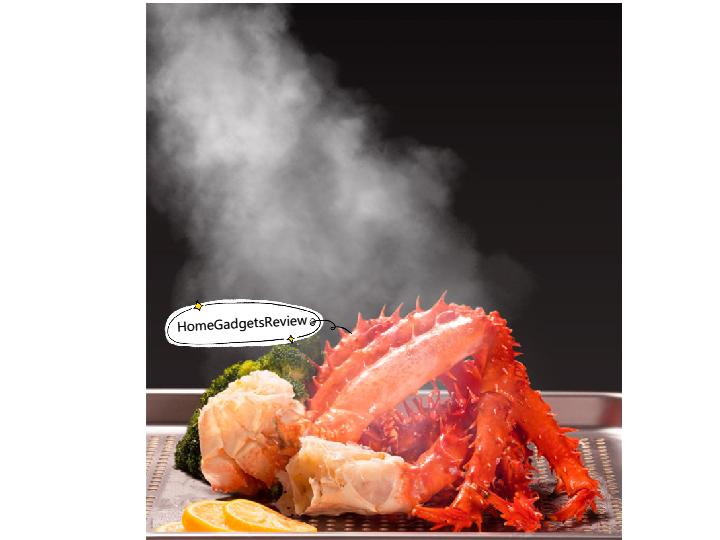
If the humidity in the oven reaches 100%, the wet-bulb temperature below 100°C = the dry-bulb temperature, and the temperature value set in the oven can be reached to the temperature value you want the food to achieve.
As long as the humidity is higher, the temperature difference between the dry-bulb temperature and the wet-bulb temperature will be smaller, so if you are not making crispy baked dishes but rapid and stable heat food, you might as well try to increase the humidity in the oven.
But the water vaporized from the ingredients is not enough, because the oven is not a completely enclosed space, it will inevitably exchange with the air outside the oven, so the water vapor overflows the oven during the exchange, so it is difficult if you want to rely solely on the vaporized water from the ingredients to maintain the oven humidity, so you will need to add additional moisture in the oven, which is why many advanced ovens have humidity adjustment functions.
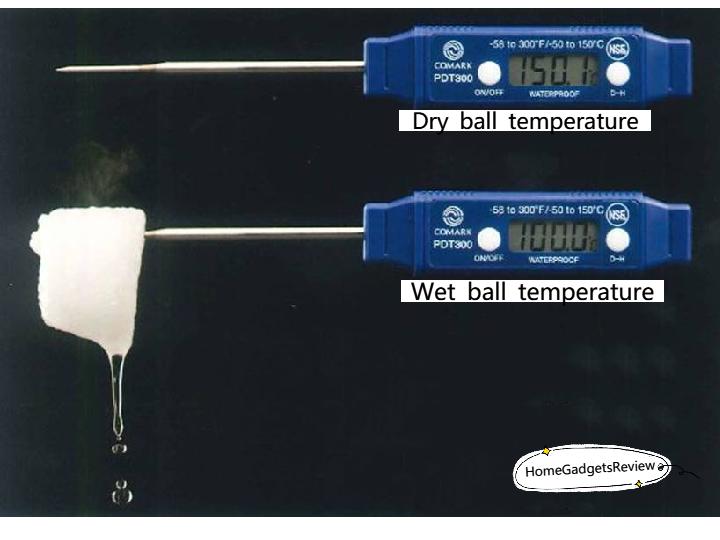
After reading this, you should be able to understand the basic heating principle of the oven. Above four heat transfer modes can occur simultaneously even in the most complicated oven.
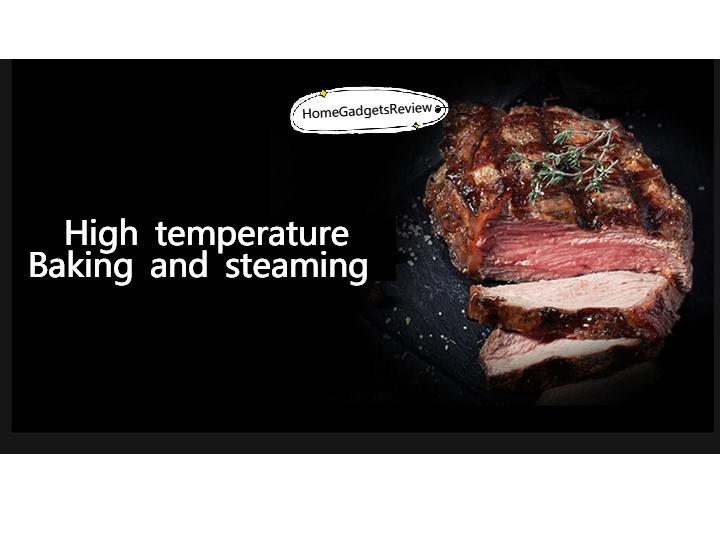
The temperature of a general household oven is below 250°C. At this temperature, heat transfer is dominated by heat convection, supplemented by heat radiation, phase change heat transfer, and heat conduction. The lower the temperature, the more important the heat convection is. On the contrary, the higher the temperature, the importance of heat radiation will gradually increase. If the temperature reaches above 800°C, the effect of heat convection will be minimal compared to the effect of heat radiation, but the general oven will not reach such a high temperature.
Then what about air fryers?
If you want to understand the principle of the fryer, you need to know the principle of "frying".
Frying mainly relies on oil as a fluid medium and raises it to a temperature higher than the boiling point of water (160°C to 180°C). At this time, due to the high temperature, the water on the surface of the ingredients will boil rapidly and change continuously. It turns into water vapor and escapes from the surface of the food (that is why there are bubbles around the ingredients when frying). The escaped water vapor quickly stirs the hot oil and forms rapid convection.
At the same time, because the water vapor escaping from the surface of the food is in gas form, it will not mix with the oil. When the water vapor has not collected a lot, a small water vapor layer will be formed on the surface of the oil and the ingredients. Large bubbles are often formed when there is more water vapor, because the water vapor density is low, the bubbles will rise to the surface of the oil and evaporate.
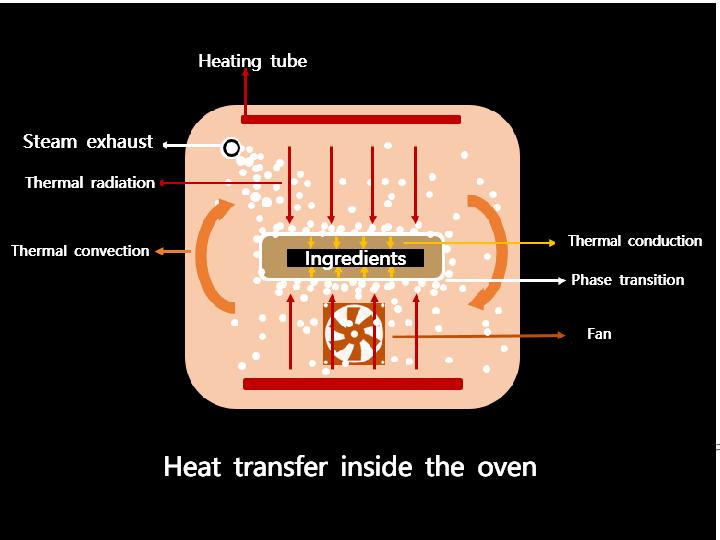
So, you think that frying is when the ingredients are immersed in an oil pan, but in fact, the oil is wrapped in water vapor, and the water vapor is wrapped in the ingredients. The time for the oil to directly contact the ingredients can be very small. The frying only uses the oil to flow. The oil can be heated to high-temperature characteristics (compared to water, the oil smoke point is much higher), the water on the surface and inside of the food can be volatilized quickly and continuously, the surface of the food can quickly reach the "dry" fried crispy state, This is the real process of frying.
In other words, the essence of frying is "quick-drying", not for the ingredients to absorb a large amount of fat, which may be different from many people's understanding of frying. In the field of food processing, there is even a concept called "oil retention", which is used to indicate how much fat the ingredients have absorbed after frying. For foods with a high oil retention rate, the oil needs to be thrown out by a centrifuge and other machines to make them light and dry.

Of course, if the ingredients are relatively dry or small, the water contained in them is relatively less. When all water is vaporized, the oil will directly contact the ingredients, and the ingredients may also absorb grease. After thin potato chips are fried and dried. , The weight of the absorbed fat may be several times of its own.
The above is the heating process of the surface of the ingredients during frying, which mainly relies on the heat convection of oil and water vapor. The inside of the food mainly relies on heat conduction. As we mentioned earlier, compared to convection, heat conduction is a very slow heat transfer method, and it has a lot to do with the thickness of the food. The thicker the food or the larger the food, the slower the heat conduction (specifically You can learn more about Fourier's heat conduction equation).
Then what problem would this cause? It is difficult to rely solely on deep-frying to make a large piece of food evenly cooked, for example, a whole chicken. You rarely hear of people taking a raw whole chicken to deep-fry, right? If you deep fry a whole chicken, either the skin will be crispy but the inside may not be cooked, or the inside will be cooked but the surface will be burnt.
Therefore, a cooking method like that of Guangdong crispy roasted chicken with hot oil spread is adopted, with which the temperature of the hot oil is slowly transferred to the inside of the chicken.
In a nutshell, in most cases of frying, we don't need oil to enter the inside of the ingredients. We just dry the surface or inside of the ingredients quickly. This is the core purpose of most deep-fried cooking.
Then, how does the air fryer simulate the cooking method of "frying"?
In fact, our goal has always been "quick drying". If this goal is achieved, it doesn't matter whether you use oil or not, unless of course, you are looking for the oily aroma attached to the surface of the food.
Does an alternative exist? Sure, just use an air fryer.
Does it feel contrary to common sense?
Let me give you the simplest example, the crispy fried chicken in the below picture. If you don't say that it is fried, many people would've thought that it was grilled.
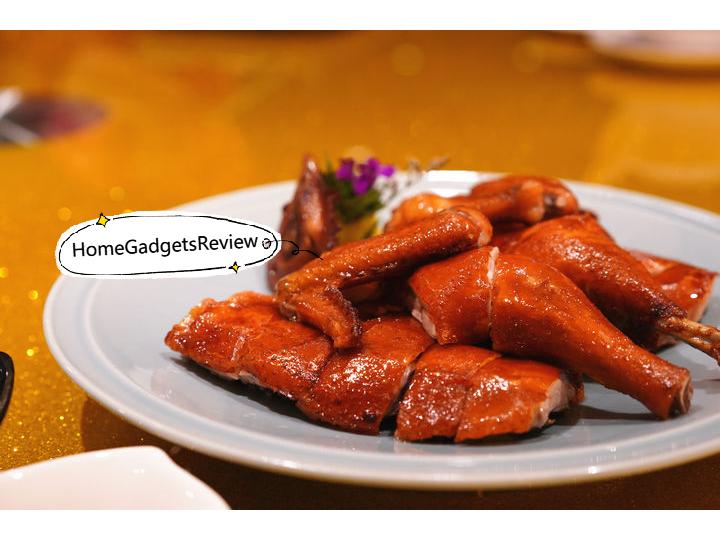
The "crispy" taste produced by the volatilization of the water under the sebum of poultry meat can indeed be produced by roasting. The simplest example is Cantonese roast goose or Beijing roast duck.
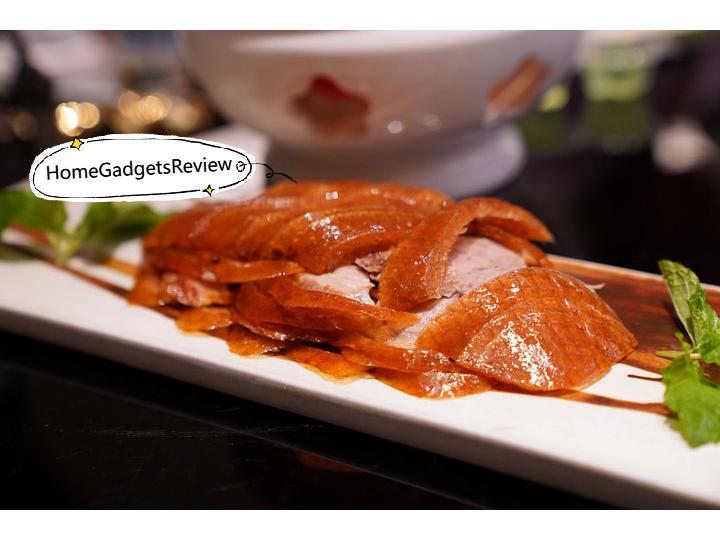
The method of roasting duck is to separate the skin and flesh of the duck (such as blowing air under the skin), and then put it in a high-temperature oven, use the hot air in the oven to bake the skin until the surface is dry and achieve a crispy state. Blowing achieves the purpose of separating the skin and the flesh, but also to prevent the moisture in the meat from directly and continuously infiltrating into the skin, thus affecting the effect of epidermal drying.
For another example, we often use the batter to wrap the ingredients for frying, and the batter on the surface after fried is very much like the texture of biscuits baked in the oven.

Because their principles are very similar in nature.
The frying process quickly took away the moisture in the batter. After it was picked up and drained, the surface of the ingredients was actually wrapped in the batter that had lost its moisture. In this sense, the oil in the batter should be as little as possible, otherwise, the batter will taste thick, greasy and not crispy. And the frying process should be as short as possible, the batter should be picked up before all moisture in the batter evaporated to prevent the oil from entering the batter.
The baking of biscuits is essentially a process of drying the batter. The hot air slowly evaporates the moisture in the batter, which in the end fully evaporates the water inside the batter, and produces a Maillard reaction, giving off a burnt scent of the baked biscuits.
So although most cookies are baked, they are actually "fried cookies".
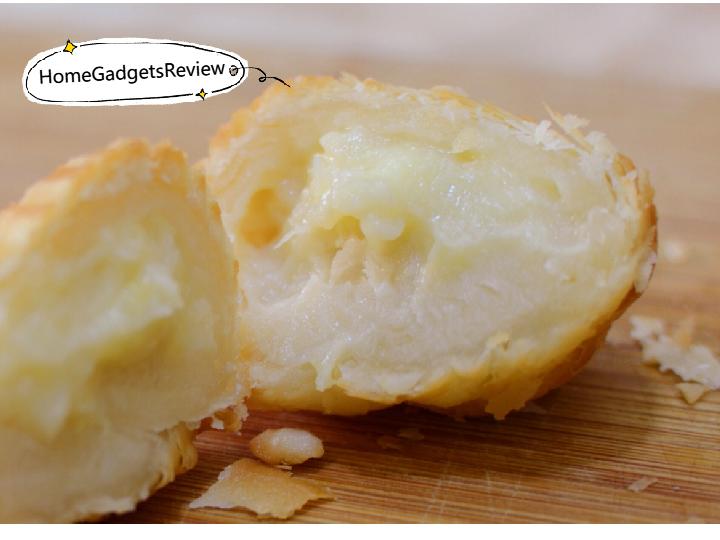
In other words, the purpose of these two methods is the same, both are to dry the surface of the ingredients. But the two methods are not completely the same. As far as making the puff pastry, the frying process of a durian puff is calculated in seconds, but it takes tens of minutes to complete the baking in the oven. This is because there is a big difference in the heat transfer efficiency between "oil" and "air".
It should be understood that the thermal conductivity of oil itself is higher than that of air, and the agitation of water vapor makes the oil flow very fast, and the heat convection is obvious. Therefore, the overall heat transfer efficiency of frying is higher than that of air roasting.
It is because frying is faster than roasting or grilling, so frying can bring a thin and crispy texture. If the drying is too slow, the surface drying speed may not be as fast as the internal moisture vaporizes, which causes a dry inside but a moisture skin.
The "air fryer" was born because the drying efficiency of the oven is relatively low. Air fryers are designed with the proposition of "air roasting" and "rapid drying". Let's briefly illustrate the difference between air frying and frying.
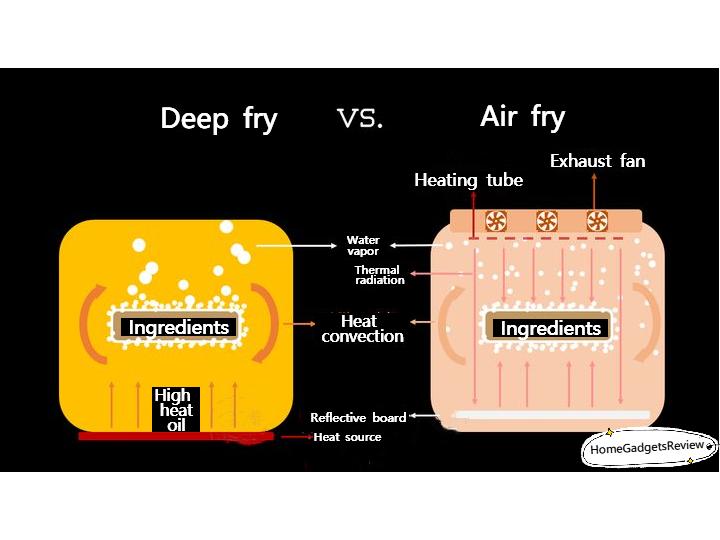
On the left is the traditional frying method. When the ingredients are deep-fried in oil, the water vapor on the ingredients surface gradually collects, forming bubbles and then rapidly expelling upward due to the difference in density. The surface of the ingredients is rapidly dehydrated and dried to form a crispy crust.
On the right is the design of an air fryer/convection oven. The heating tube in the cavity is generally a hidden design, the bottom may be a heating tube or it may be a reflective metal plate.
The heating tube will fully heat the air inside the cavity, and the ingredients are also heated under the action of heat radiation and thermal convection. The surface moisture of the ingredients will continue to evaporate (but much slower than frying), but with the help of a high-power exhaust fan, The moisture inside the oven is discharged from the cavity, dry and cold air enters the oven to replace the humid hot air, and then is reheated and reciprocated. Finally, the surface of the ingredients also reaches the drying effect, forming a crispy crust.
What is the difference between an oven and an air fryer?
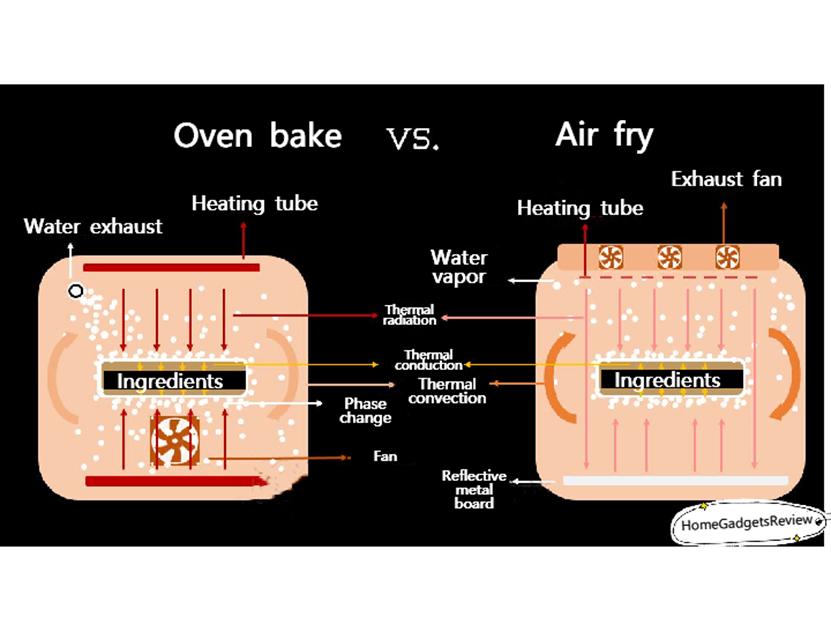
Their essence is to use the heating tube as a heat source to heat food and air, and then the heat convection of the air further heats the food.
The outstanding difference between an air fryer and an ordinary oven is:
1. The fan power of the air fryer is often very large and the heat convection is more intense, and it is made into an exhaust fan.
This design helps to form strong heat convection inside the air fryer, and at the same time quickly exhausts the moisture in the cavity, so that the surface of the food can be air-dried.
The fan power of ordinary ovens is not high, and it only provides basic convection without heating, unless it is a blast stove type oven.
2. The heating tube of the air fryer is generally a hidden design, and bottom heating tubes often do not exist. The heat radiation effect is weakened so that the entire heating process depends more on heat convection.
Therefore, it is the basic idea of design to reduce the effect of heat radiation as much as possible and increase the intensity of heat convection. So that the ingredients will have a crispy outside and fully cooked inside.
The oven is very dependent on heat radiation, even adding a lot of heating tubes or increasing the curved area of the heating tubes to enhance the effect of heat radiation.
3. Air fryer is generally smaller, which makes the effect of heat convection more direct than the oven.
As mentioned earlier, heat radiation is a kind of light, and the distance from the ingredients determines the heating effect. Generally, the oven will be made larger and higher in height, so that you can adjust the ingredients up and down.
The air fryer does not need obvious heat radiation, so a smaller machine is not a big problem, even improves the heating efficiency.
4. The air fryer does not have too many complicated functions, and the power of the heating tube on the fan is also relatively high. Generally, all cooking can be completed by relying on hot air.
The oven generally gives you independent control of the upper and lower pipes, and some ovens even produce steam.
In short: the air fryer is a small convection oven on steroids.
The problem that many people are struggling with is how to choose between the two.
1. If you have enough budget, buy a high-power convection oven, the one that has the functions of an oven and an air fryer.
2. If you really like fried food but with a limited budget. You can consider buying an air fryer, but it is recommended to consider the ones with a larger inner cavity, which is more heating and drying than an oven of the same price and has a wider range of applications than the entry-level small oven.
3. If you are single or a couple, you might will never turn on the traditional oven once you had an air fryer. An air fryer can't completely replace the oven, but all the smaller stuff it knocks out of the park: French fries, corndogs, tater tots, baked potatoes, to fry chicken breasts for sandwiches, even to brown sausages for gumbo. Not mention conventional oven takes forever to preheat and it doesn’t go easy on the electricity bills.
Is air fryer a scam?
There are some companies out there just slapping together something they can call an air fryer. And there are some big kitchen appliance manufacturers who jumped on the bandwagon too fast. But if you read the reviews, you should be able to find an air fryer that meets your needs. Get the wrong air fryer, and you might think it’s a scam, take the time to find the right one, and you’ll be amazed.
Coocaa air fryer AF-DE1 is the next generation kitchen gadget you deserve.
1. Budget friendly, coocaa is branded for young people, for those who are on a budget but don’t want to sacrifice quality living. Come and take a look at what coocaa air fryer has to offer: https://bit.ly/3BgwiN3
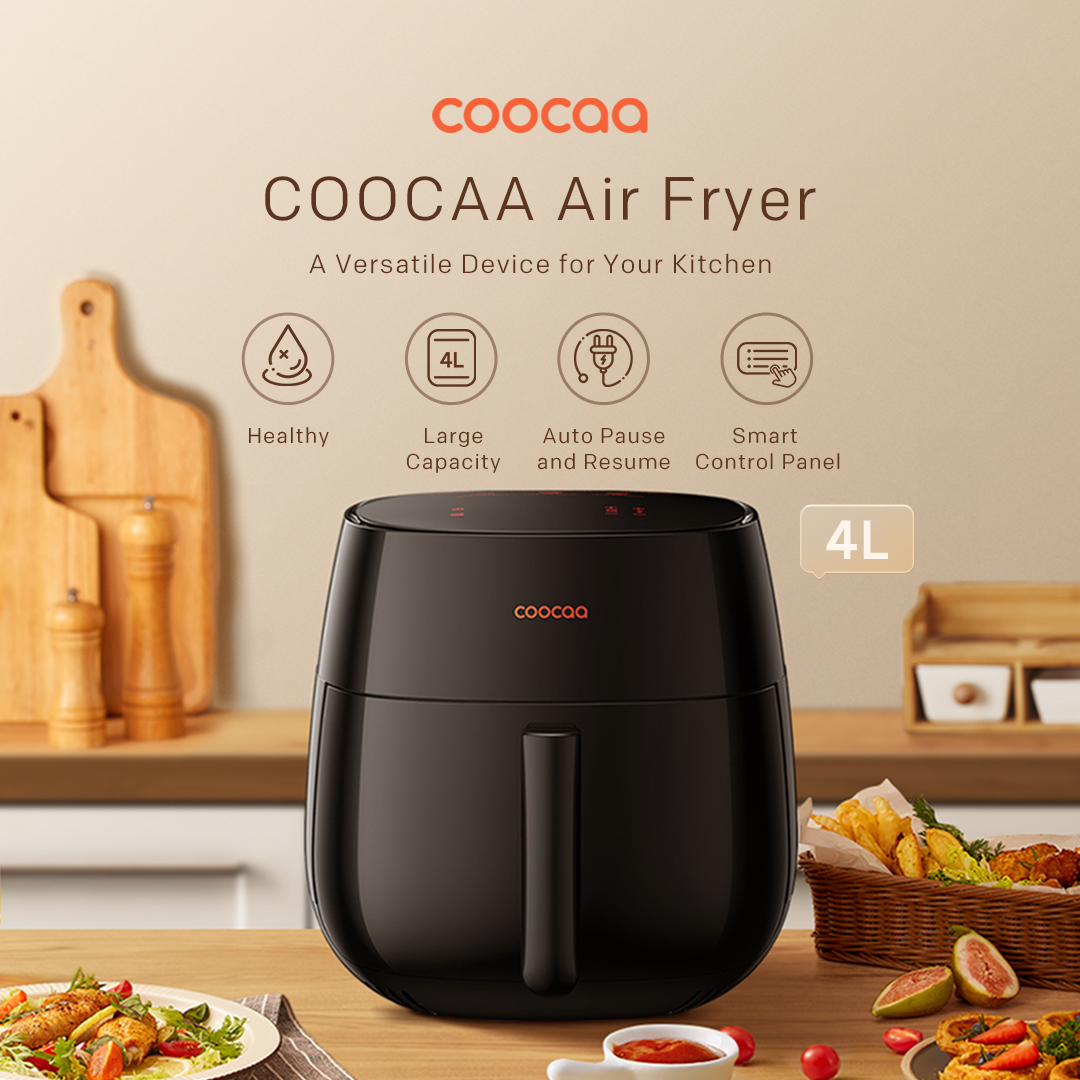
2. 4 liters large capacity, enough for you to air-fry a whole chicken.
3. 1400W high cooking power, achieving soft inside and crispy outside with ease.
4. 360° hot air circulation, expediting thermal convection.
5. Pre-set smart menu to save you the hassle from remembering the temperature and time.
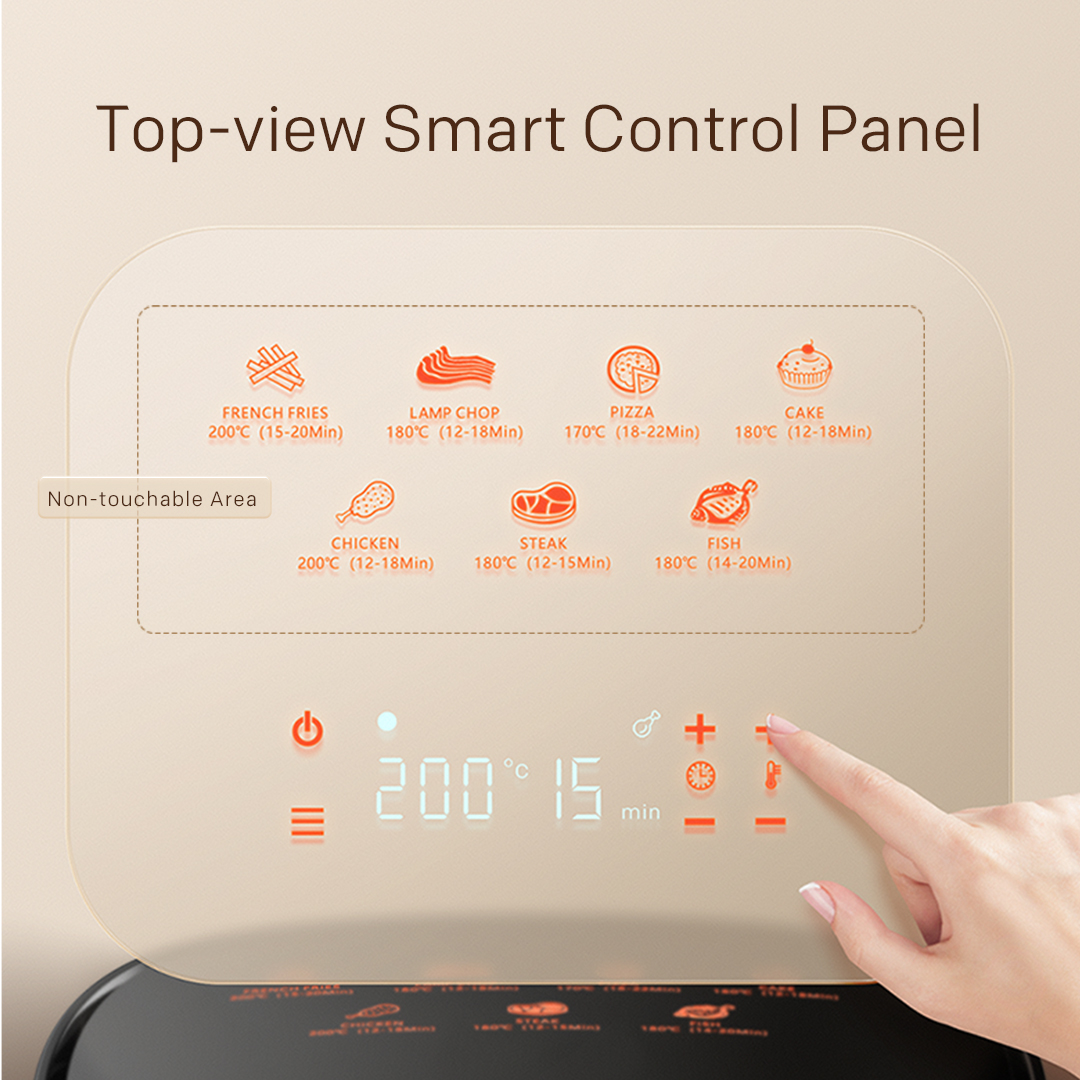
6. Auto pause and resume when pulling out and pushing back the frying basket.
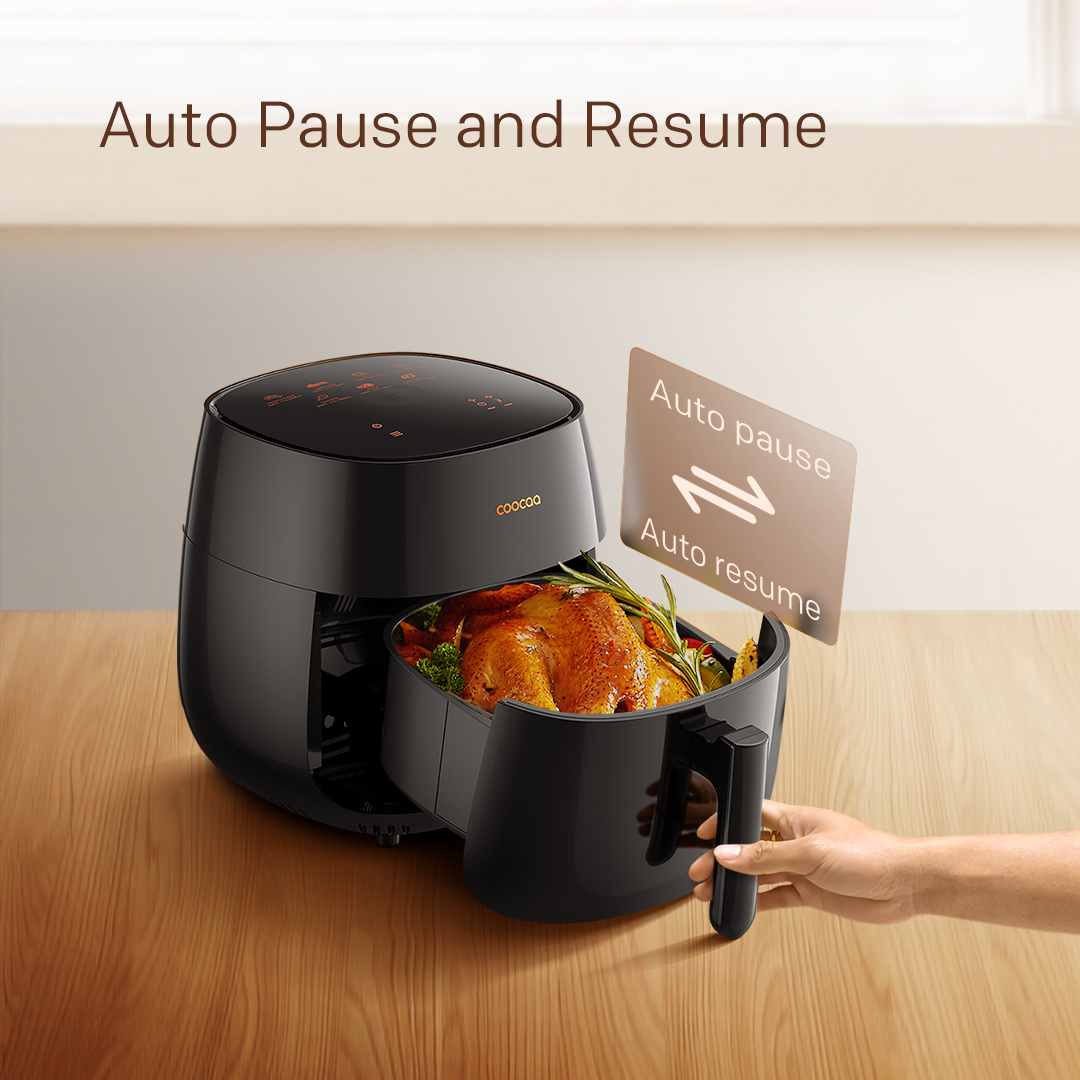
7. Non-mechanic premium touchable control panel, easy to clean and last longer. https://bit.ly/3BgwiN3
8. Food graded nonstick coating, just rinse under water to have it clean.
Recive half year extended warrenty and many more